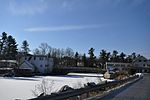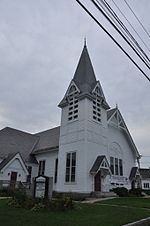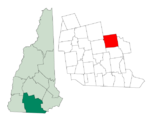WGIR-FM
WGIR-FM (101.1 MHz) is a commercial radio station in Manchester, New Hampshire, airing a mainstream rock radio format, branded as Rock 101. The station serves the Merrimack Valley area (including Concord and Nashua), and is owned by iHeartMedia, Inc., America's largest owner of radio stations. According to Nielsen Audio, WGIR-FM is usually the #2 rated radio station in the Manchester radio market behind 95.7 WZID. Weekdays begin with the comedy radio show Greg and the Morning Buzz, hosted by Greg Kretschmar. It is shared with co-owned 100.3 WHEB in Portsmouth, and also heard on 104.9 WLKZ in Wolfeboro. The rest of the day, local DJs are heard. On Sunday nights, WGIR-FM carries the syndicated radio show The House of Hair with Dee Snider. WGIR-FM's studios and offices are on Foundry Street in Manchester. The transmitter is on Mount Uncanoonuc, off Perimeter Road in Goffstown, near other towers serving Southern New Hampshire TV and FM stations.Following the demise of WAAF (107.3 FM) with its sale to the Educational Media Foundation, WGIR-FM has gained listenership in the northern parts of Greater Boston and Worcester County, Massachusetts, alongside Providence, Rhode Island sister station WHJY (94.1 FM), though WHJY has a clearer signal in much of the Boston area compared to WGIR-FM's signal.
Excerpt from the Wikipedia article WGIR-FM (License: CC BY-SA 3.0, Authors).WGIR-FM
Perimeter Road,
Geographical coordinates (GPS) Address Nearby Places Show on map
Geographical coordinates (GPS)
| Latitude | Longitude |
|---|---|
| N 42.982 ° | E -71.589 ° |
Address
Perimeter Road
03045
New Hampshire, United States
Open on Google Maps









